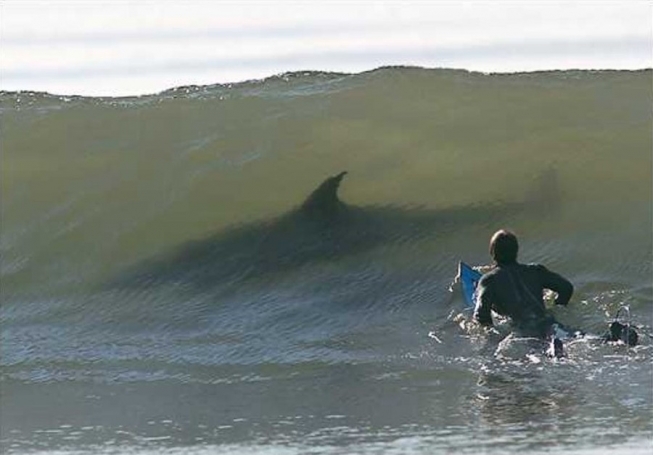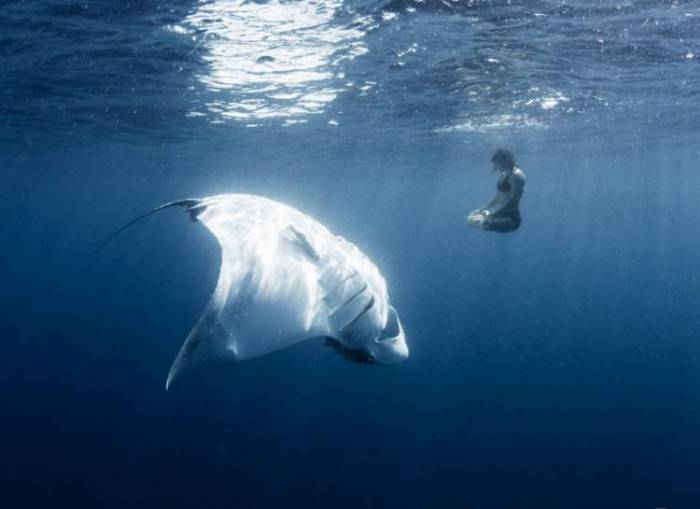
[onepage]
[gallerypage]
The ocean is considered to be quiet and peaceful. Many people chose to relax, change air or break the monotony of everyday life at the beach. They sunbathe, swim and engage in entertaining activities in the ocean without really knowing what lives down there. Some of the most dangerous creatures can be swimming right next to you. Look at how scary the sea can be.
1. An unexpected savior

The shark supposedly guided this man who spent 15 weeks drifting aimlessly in the middle of the Pacific Ocean.
[/gallerypage]
[gallerypage]
2. Shark

This picture was taken at the Noordhoek Beach in Cape Town, South Africa. Several shark attacks have occurred at this beach in the past. Hopefully, this surfer managed to stay away from the animal’s sight.
[/gallerypage]
[gallerypage]
3. Kicking it with whale sharks

This photo was taken during a feeding frenzy where more than 600 whale sharks gathered to feed on tuna spawn. These creatures’ mouths measure up to 1.5 metres wide, and they can have up to 350 rows of teeth.
[/gallerypage]
[gallerypage]
4. Sushi time!

Whether they are dangerous Pacific black dragons or simply algae, they definitely are not what you’d want to be surfing around. Male black dragons usually grow and live until they mate and die once they mate.
[/gallerypage]
[gallerypage]
5. Manta rays

She looks so calm and collected. Some of you may think that she is in danger but mantas, which are popular in tourist sites, are easily habituated to humans. Indonesia has 2.2 million square miles of ocean. It is the world’s largest sanctuary for manta rays.
[/gallerypage]
[gallerypage]
6. Shark attack

Sharks don’t hurt…unless you bother them. This shark in question is a great white shark, arguably the world’s largest known extant macropredatory fish. Mature great white sharks can measure up to 6.4 m.
[/gallerypage]
[gallerypage]
7. A drop in the ocean

Mother earth is full of unexplored spaces, and many of them are underwater. The deepest part of the ocean is called the Challenger Deep. It is about 11,033.76 m. deep.
[/gallerypage]
[gallerypage]
8. A giant monster

The lion’s mane jellyfish, also known as hair jelly, is the largest known species of jellyfish. Its stings can hurt, but they are not known to be fatal. The largest recorded specimen was found on the shore of the Massachusetts Bay in 1870. It had a bell with a diameter of 2.3 m. and tentacles 37 m. long.
[/gallerypage]
[gallerypage]
9. A giant tiger shark

The ocean hides a thousand of secrets. Who knows what could be hiding right under your tiny boat? The tiger shark is a solitary, mostly nocturnal hunter. It is notable for having the widest food spectrum of all sharks. It consumes a variety of prey ranging from crustaceans, fish, seals, birds, squid, turtles, and sea snakes to dolphins and even other smaller sharks.
[/gallerypage]
[gallerypage]
10. Close call

Surfer Mick Fanning was close to getting attacked by a shark. He fought off the shark and narrowly escaped the attack during the J-Bay Open surfing competition in South Africa. He is brave, isn’t he?
[/gallerypage]
[gallerypage]
11. Feeling lonely?

Swimming trough waters full of jellyfish sounds like the craziest idea ever. Contact with a jellyfish tentacle can trigger millions of nematocysts to pierce the skin and inject venom, but most jellyfish stings are not deadly.
[/gallerypage]
[gallerypage]
12. In very good company

A man went along the Mexican shores and was invaded by thousands of stingrays. What a scene! Stingrays are common in coastal tropical and subtropical marine waters throughout the world.
[/gallerypage]
[gallerypage]
13. Northern stargazer

This creepy animal burrows in the sand and electrocutes everything that passes by. It can be found up to depths of 36 m. The mouth of the stargazer faces up so that it can ambush prey while hiding in the sandy bottoms of coastal bodies of water and the top of it can generate and transmit an electric shock.
[/gallerypage]
[/onepage]







